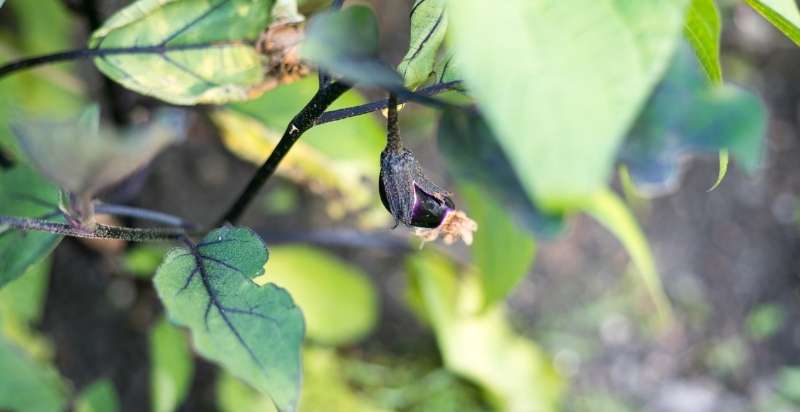Eggplant is a popular vegetable that can be used in a variety of dishes, from ratatouille to eggplant parmesan. While buying eggplant at the grocery store is possible, there is nothing like harvesting your home-grown eggplants.
If you are thinking about growing eggplants, here is everything you need to know about eggplants.
What is Eggplant?
Eggplant, or Solanum melongena, is a nightshade species native to India and Sri Lanka. The egg-shaped fruit is commonly used as a vegetable in South Asian and Southeast Asian cuisine. The plant has a long history of cultivation, with evidence suggesting that it was first grown in China over 4,000 years ago.
The scientific name for eggplant is Solanum melongena, a member of the Solanaceae family, which also includes tomatoes, potatoes, and peppers. Eggplant is classified as a fruit, but it is commonly used as a vegetable in cooking. The egg-shaped fruit has smooth, glossy skin that can be purple, black, white, or green. The fruit’s flesh is creamy white and contains small, edible seeds.
Eggplant is a warm-weather crop that thrives in tropical and subtropical climates. It is a popular ingredient in South Asian and Southeast Asian cuisines, often used as a meat substitute. The fruit can be eaten cooked or raw and is commonly used in stir-fries, curries, and salads. Eggplant is also a popular topping for pizzas and pastas.
Eggplants come in a variety of shapes, sizes, and colors.
- The globe eggplant is the most popular variety, dark purple and about the size of a chicken egg.
- Other common varieties include Japanese eggplants, long and slender, and Italian eggplants, which are oval-shaped and have a deep purple color. There are also white varieties of eggplant.

History of Eggplants:
Eggplants are native to India and have been cultivated in other parts of Asia for centuries. In the 16th century, they were first brought to Europe and the Americas in the 18th century.
The eggplant was first mentioned in writing in work called The Travels of Marco Polo, published in the 14th century. In this work, Polo described a fruit he saw in India that was “the size of a goose egg.”
Eggplants were brought to Europe by Spanish and Portuguese explorers. They were initially used as ornamental plants, as people believed they had medicinal properties. Traders and colonists later introduced Eggplants to Africa and other parts of the world.
Nutritional Benefits of Eggplants :
Eggplant is a nutrient-dense food that provides many health benefits. Eggplant is low in calories and fat and high in fiber. Additionally, it includes necessary vitamins and minerals, such as potassium, magnesium, and vitamin C. Additionally, eggplant is a good source of antioxidants.
The skin of the eggplant is especially rich in nutrition, and it contains a compound called nasunin, an antioxidant that has been shown to protect cells from damage. Nasunin is also thought to have anti-cancer properties. Additionally, the skin of eggplant contains soluble fiber, which can help lower cholesterol levels.
Eggplants are a good source of dietary fiber, which can help to promote regularity and prevent constipation. They also include plenty of antioxidants, including polyphenols and flavonoids. These compounds can help protect cells from damage by free radicals and may also have anti-inflammatory effects.
Eggplants are a low-calorie food and a good source of vitamins and minerals. One cup of cooked eggplant contains only 35 calories, but it provides over 10% of the Daily Value (DV) for vitamins B6, C, copper, and manganese. Eggplants also contain smaller amounts of other vitamins and minerals.
The health benefits of eggplants may extend to preventing and treating some chronic diseases. For example, observational studies have found that people who eat more eggplant are at lower risk for developing type 2 diabetes and cardiovascular disease. These effects may be due, in part, to the antioxidants and fiber in eggplants.
5 Tips for Growing Eggplant:
If you’re thinking about growing eggplants in your garden, there are a few things you should know first, such as :
Climatic Requirements
Eggplant is a tropical plant that originated in India and requires warm temperatures for the best growth. It is susceptible to frost and can be killed by temperatures below 50°F.
Eggplant grows best under long-day conditions; however, some varieties will produce fruit under short days. The length of daylight affects not only the number of fruits produced per plant but also the size of the individual fruits. Long days result in more fruits that are smaller in size, while shorter days result in fewer larger fruits.
Soil Requirements
Eggplant needs well-drained fertile soil with a pH between 6.0 and 7.0. The recommended fertilizer application is 200-300 lb/acre of 5-10-5 or its equivalent.
Eggplant is a heavy feeder and requires frequent fertilization, especially when grown on sandy soils.
Compost or other organic matter should be added to the soil before planting to improve its water-holding capacity and nutrient retention.
Eggplant is sensitive to several soil-borne diseases, including verticillium wilt, fusarium wilt, nematodes, and root knot. These problems can be minimized by crop rotation, selecting resistant cultivars, and using clean seeds.

Water Requirements
Eggplant requires consistent moisture for optimal growth and fruit production. Drought stress during flowering results in poor fruit set, while drought stress during fruit development results in small fruits with poor color. Irrigation is required during dry periods.
Now that you have understood the requirements of eggplants. Here are five tips for growing excellent eggplant:
1. Start with healthy plants.
2. Give them plenty of space.
3. Keep them warm and humid.
4. Water regularly and fertilize monthly.
5. Harvest when the fruit is ripe.
Remembering these pointers, you’ll be well on your way to growing a bountiful crop of eggplants that you can enjoy all season long.
Tip 1: Start with healthy plants
Eggplants are relatively easy to grow, but starting with healthy plants is important. If you’re buying seedlings, look for ones with strong, green stems and healthy-looking leaves. Avoid any that are wilted or have yellowing leaves.
If you’re starting from seed, sow the seeds in a sterile potting mix about six weeks before the last frost date in your area. Place the pots in a warm location and keep the soil moist but not saturated. In seven to ten days, the seeds will begin to sprout.
Once the seedlings have two sets of true leaves, thin them so that only the strongest plant remains in each pot. Transplant the seedlings into the garden after all danger of frost has passed.
Tip 2: Give them plenty of space
Eggplants require plenty of space to grow and produce a good fruit crop; each plant should have about two feet of space around it. If you’re growing more than one variety, plant them in separate areas to prevent cross-pollination.
When you are transplanting the seedlings into the garden, dig a large enough hole to accommodate the root ball. Now gently loosen the roots and place the plant in the hole so that the top of the root ball is even with the soil surface. Backfill the hole and water the well.

Tip 3: Keep them warm and humid
Eggplants are warm-season plants that prefer temperatures between 60 and 85 degrees Fahrenheit. They also like high humidity, so if you live in an area with low humidity, you may need to provide some additional moisture.
One way to increase the humidity around your plants is to mulch with organic material such as straw or shredded leaves, which will help hold in moisture and keep the roots cool.
You must routinely spritz the plants with water or set up a humidifier near them. Just be sure not to place it too close, as this could cause a leaf drop.
Tip 4: Water regularly and fertilize monthly
Eggplants need consistent moisture to produce good fruit. Water them deeply and regularly, especially during dry spells. Try always to keep the soil moist but not soggy.
Fertilize your eggplants monthly with a balanced fertilizer such as 10-10-10. Eggplants are heavy feeders, so you may need to adjust the amount of fertilizer you use depending on the soil test results.

Common problems with eggplant plants and their prevention :
Eggplant plants are susceptible to some pests and diseases. The most common include:
Aphids: These small, pear-shaped insects suck the sap from eggplant leaves and stems, causing the leaves to curl and the plant to become stunted. To get rid of aphids, blast them off the plant with a strong stream of water or spray them with insecticidal soap.
Caterpillars: Caterpillars, such as the tobacco budworm, can destroy eggplant crops, and they feed on the leaves and fruit of the plant, causing extensive damage. To control caterpillars, use a biological insecticide such as Bacillus thuringiensis (BT) or spinosad.
Cutworms: Cutworms are destructive pests that feed on the stems of eggplant plants, causing them to wilt and die. To control cutworms, keep your garden clean and free of debris. You can also use a biological insecticide such as BT or spinosad.
Eggplants are also susceptible to some diseases, including:
Anthracnose: This fungal disease affects the fruit of the eggplant plant, causing it to rot. To prevent anthracnose, water the plants at the base instead of above to avoid getting water on the leaves and fruit.
Bacterial wilt: This bacterial disease is spread by cucumber beetles and other insects that feed on the plants, and it causes the leaves of the plant to wilt and die. To prevent bacterial wilt, use row covers to keep insects away from the plants.
Fusarium wilt: This fungal disease affects the roots and stems of eggplant plants, causing them to wilt and die. To prevent fusarium wilt, plant resistant varieties and water the plants at the base instead of from above.
Verticillium wilt: This fungal disease affects the roots and stems of eggplant plants, causing them to wilt and die. To prevent verticillium wilt, plant resistant varieties and water the plants at the base instead of from above.
With proper care, eggplant plants will produce bountiful crops of delicious fruit. Following the tips above, you can enjoy a healthy harvest of eggplants all season long.
Tip 5: Harvest when the fruit is ripe :
Eggplants are ready to harvest when the fruit is firm and glossy, and the skin should give slightly when you press on it with your thumb. Depending on the variety, eggplants will be ready to harvest in 60-90 days after planting.
If you wait too long to harvest, the eggplant will begin to shrivel, and the skin will turn brown. The flavor of the fruit will also decline.
Cut the stem with a sharp knife or pruning shears to harvest, leaving a short stem attached to the fruit. Eggplants can be stored in the refrigerator for up to a week.
After harvest, store the eggplants in a cool, dark place until you are ready to use them. Eggplants can last up to two weeks when stored properly.
When ready to use the eggplants, wash them thoroughly under cool, running water. Cut off the stem and any bruised or damaged areas. Eggplants can be eaten raw, cooked, or pickled. They can also be used in various recipes, such as ratatouille, eggplant parmesan, and baba ghanoush.
No matter how you choose to enjoy your eggplants, they will be sure to add a delicious touch to your meal.

Additional Caring Tips For eggplant :
To get the most out of your eggplant plants, follow these additional care tips:
Pruning:
Pruning your eggplant plants regularly encourages new growth and prevents the spread of diseases. Remove dead or diseased leaves, stems, or fruit from the plant.
To prune an eggplant plant:
- Start by cutting off dead or diseased leaves, stems, or fruit.
- Cut back any long or leggy stems to encourage new growth.
- Make all cuts cleanly and at a 45-degree angle.
Eggplant plants can be pruned throughout the growing season as needed.
Staking:
Eggplant plants can get top-heavy with fruit, so be sure to stake them up to prevent them from toppling over.
To stake an eggplant plant:
- Drive a long stake into the ground next to the plant.
- Use a stake that is taller than the plant.
- Tie the eggplant plant to the stake using twine or gardening wire.
Eggplant plants must be staked up as they grow and produce fruit.
By following these care tips, you can ensure that your eggplant plants are healthy and productive all season long!
Cooking Tips
Eggplants can be eaten cooked or raw. When cooking eggplants, it is important to note that they absorb a lot of oil. To avoid this, you can cook them in a dry method such as grilling or baking. Eggplants can also be roasted, sautéed, or stir-fried.
If you are new to cooking with eggplants, here are some recipes to get you started:
Roasted Eggplant: Cut eggplant into thin slices and roast in a preheated oven at 400 degrees Fahrenheit for 20 minutes.
Sautéed Eggplant: Sauté sliced eggplant in olive oil over medium heat until browned.
Stir-Fried Eggplant: Stir-fried sliced eggplant in a wok or frying pan with oil and your choice of vegetables and seasonings.
Eggplant Parmesan: This classic Italian dish is made by layering slices of eggplant with tomato sauce and mozzarella cheese, then baking in a preheated oven until the cheese is melted and bubbly.

Possible Side Effects Of Eating Eggplant
Eggplants are a healthy and delicious addition to any diet. However, you should be aware of a few potential side effects before eating them.
1. Eggplants contain solanine, a compound that can be toxic in large amounts. Solanine is found in all nightshade family members, including eggplant, tomato, potato, and pepper. While small amounts of solanine are not harmful, eating large quantities can cause nausea, vomiting, and diarrhea. If you experience these symptoms after eating eggplant, seek medical attention immediately.
2. Eggplants can also cause allergies in some people. The most common symptom of skin irritation, but some people may also experience difficulty breathing, swelling of the throat, and anaphylaxis. If you are allergic to eggplant, avoid eating it and seek medical attention if you experience any symptoms.
3. Eggplants are high in oxalates, which can contribute to kidney stones in some people. If you have a history of kidney stones, talk to your doctor before adding eggplant to your diet.
4. Eggplants contain large amounts of nicotine, harming pregnant women and their developing babies. If pregnant or breastfeeding, talk to your doctor before eating eggplant.
5. Some people may experience digestive issues after eating eggplant, which is most likely due to the vegetable’s high fiber content. If you experience bloating, gas, or constipation after eating eggplant, try consuming smaller amounts and drinking plenty of water.
Conclusion
Eggplant plants are easy to care for and can provide a bountiful harvest of delicious fruit. To ensure a healthy crop, water the plants at the base instead of above, use row covers to keep insects away, and regularly prune the plants.
Eggplants are ready to harvest when the fruit is firm and glossy and can be stored in the refrigerator for up to a week. Enjoy your eggplants raw, cooked, or pickled!
- Everything You Wanted to Know About Red Tamarillos - June 2, 2025
- A Guide to Tulips: Everything You Need to Know & More… - June 2, 2025
- Guanabana: Description, Flavor, Benefits, And Uses - May 27, 2025
